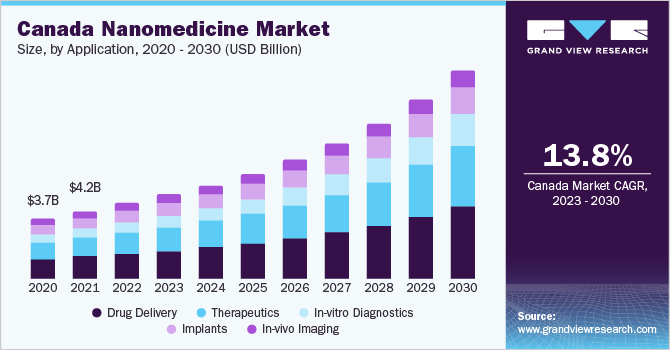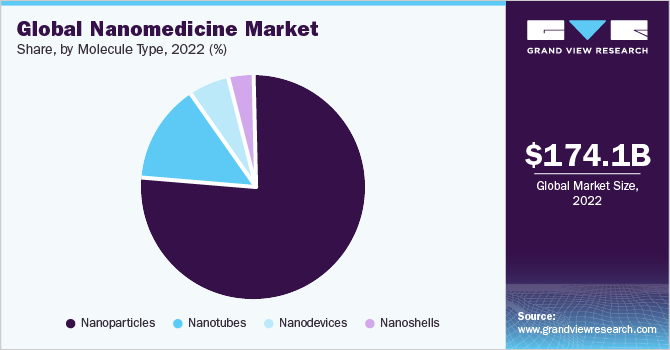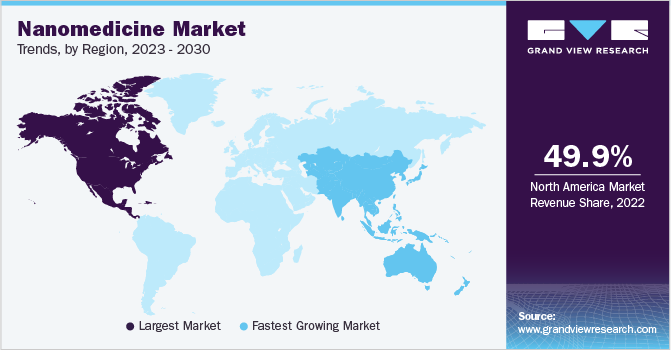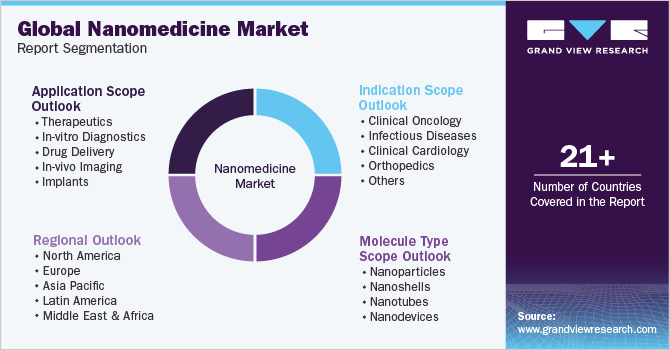- Home
- »
- Pharmaceuticals
- »
-
Nanomedicine Market Size, Share & Growth Report, 2030GVR Report cover
![Nanomedicine Market Size, Share & Trends Report]()
Nanomedicine Market Size, Share & Trends Analysis Report By Application (Drug Delivery), By Indication (Clinical Oncology, Infectious Diseases), By Molecule Type, By Region, And Segment Forecasts, 2023 - 2030
- Report ID: 978-1-68038-942-5
- Number of Pages: 125
- Format: Electronic (PDF)
- Historical Range: 2018 - 2021
- Industry: Healthcare
Nanomedicine Market Size & Trends
The global nanomedicine market size was valued at USD 174.13 billion in 2022 and is expected to grow at a compound annual growth rate (CAGR) of 11.57% from 2023 to 2030. Significant developments and recent commercialization of products, such as mRNA and liposome-based vaccines are expected to drive the growth of nanomedicines in the near future. Furthermore, the growing adoption of nanotechnology-based methods for drug delivery and the prevalent inefficiency of conventional therapeutics represent emerging growth prospects for the nanomedicine industry.

The COVID-19 pandemic had a positive effect on the nanomedicine industry as the disease increased the need for nano-medicines for the development of advanced therapeutics and vaccines to control outbreaks. Similarly, increasing interest in applications of nanomedicine for the introduction of innovative solutions for the prevention, detection, and treatment of other viral diseases similar to COVID-19 are also expected to boost industry growth.
Furthermore, the active participation of well-established pharmaceutical companies in the development of novel nanoscience-based therapeutics is anticipated to influence the growth of the nanomedicine market. For instance, in May 2022, the Marble Center for Cancer Nanomedicine launched an affiliate program in collaboration with Alloy Therapeutics, FUJIFILM Holdings America Corporation, Sanofi, and Danaher Corporation.
The program aims to foster scientific collaborations between the industry and academia, to fuel breakthrough innovations in the nanomedicine industry. Moreover, advancements in nanotechnology and its expanding applications in preventive interventions, early disease diagnosis, prevention of chronic as well as acute disorders, and prophylaxis of acute as well as chronic disorders are expected to spur the nanomedicine industry's growth.
Manufacturers are capitalizing on the strong growth prospects in the global market as a result of the growing demand for nanomedicines. Furthermore, it is projected that the increasing involvement of key pharmaceutical companies in the production of advanced nanoscience-based medicines will have an impact on the development of this industry.
Government organizations are likely to increase their R&D funding, opening up attractive opportunities for market expansion. Governmental funding aids in accelerating massive capital-intensive projects. For instance, the National Science Foundation stated in August 2020 that it will invest a total of USD 84 million over five years in re-establishing the National Nanotechnology Coordinated Infrastructure to advance nanoscale engineering, science, and technology. Moreover, The Canadian Institutes of Health Research (CIHR) and the Canadian Space Agency (CSA) are funded by the Canadian government for research in the field of nanomedicine and regenerative medicine. Therefore, it will drive the nanomedicine industry growth in the coming years.
Application Insights
The drug delivery segment dominated the nanomedicine market in 2022 with a share of 34.09% as a result of the rising rates of several chronic and infectious diseases including cancer and COVID-19 as well as growing public awareness of the potential uses for nanomedicines. In addition, growth in research activities exploring the potential applications of nanomedicines in drug delivery is boosting the segment. For instance, in March 2023, researchers atMemorial Sloan Kettering Cancer Center and Mount Sinai Health System developed a new drug delivery method for targeted delivery of anti-cancer drugs for the treatment of brain tumors in children.
The therapeutics segment is anticipated to witness the fastest growth rate of 12.79% from 2023 to 2030, due to the availability of numerous products that fit into this category for the treatment of various ailments. This application of nanomedicine includes revenues generated from medications, equipment, and drug delivery systems. Additionally, technological advancements facilitating the development of nanotherapeutics that can cross biological barriers are anticipated to drive the market over the forecast period.
Indication Insights
The clinical oncology segment dominated the market with a share of 32.44% in 2022. The increased prevalence of cancer disorders has resulted in a vast number of cancer treatment products now in the clinical stages of development as well as developments in the introduction of therapeutic particles and devices. Clinical oncology also encompasses several active and passive cancer-targeting techniques within the nanomedicine industry and is thus expected to grow over the forecast period.
The infectious disease segment is expected to grow at a rapid CAGR of 12.31% by 2030 due to the increasing need for developing rapid, efficient, and cost-effective therapies for infectious diseases. Nanomedicine is a rapidly evolving treatment modality owing to its targeting efficiency and fewer adverse effects. Thus, targeting a wide variety of infectious diseases is possible and it represents promising growth prospects for the nanomedicine industry.
Molecule Type Insights
The nanoparticles segment captured the highest market share of 76.32% in 2022 due to the benefits that various nanoparticles offer, as well as the growing usage of metal and metallic oxide particles in photodynamic therapy (PDT) for the treatment of infectious diseases and cancer. Several companies in this domain are also undertaking initiatives to develop novel technologies using nanoparticles. For instance, in January 2022, NaNotics LLC started a research cooperation with Mayo Clinic to develop a NaNot, a subtractive nanoparticle that specifically targets the soluble form of the immune inhibitor PD-L1, which is produced by tumors.

The nanotubes segment is expected to grow at a significant CAGR of 10.90% from 2023 to 2030 as the rising demand for nanotube products in various healthcare settings is anticipated to spur expansion in the upcoming period. These molecules can carry out a variety of tasks owing to their capacity to bind to chemical moieties in the form of scaffolds. For instance, the incorporation of carbon nanotubes into scaffolds for tissue engineering can improve scaffold properties and lead to enhanced tissue regeneration. Such emerging applications of nanotubes are fueling the nanotubes segment in the nanomedicine industry.
Regional Insights
North America dominated the market with a share of 49.91% in 2022. Throughout the projected period, the region is expected to retain its leadership. This expansion is due to the presence of expanding partnerships between businesses working in this area and nanomedicine start-up companies. Furthermore, the region is favored by the support from governmental authorities combined with rising R&D expenditures. The nation also boasts a sizable number of manufacturing firms with active strategic ventures in the nanomedicine industry. To speed up the development of its drug delivery development platform focused on nanoparticles to treat peripheral artery disease and other various applications, for instance, Advanced NanoTherapies raised USD 5.3 million in seed-round financing in October 2020.

The Asia Pacific market is expected to grow at the fastest CAGR of 14.07% during 2023-2030. This can be attributed to the increasing awareness about nanomedicine and rising public engagement in consensus conferences connected to nanoscience and nanotechnology. For instance, in August 2022 Beijing, China hosted the 9th International Conference on Nanoscience and Technology, China (ChinaNANO 2022). The conference's goal is to disseminate scientific breakthroughs, developments in specific industry areas, technical advancements, and new possibilities and problems
Key Companies & Market Share Insights
Key players in the market are undertaking several strategies including partnerships, mergers and acquisitions, geographical expansion, and strategic collaborations for strengthening their market presence. For instance, in March 2023, Moderna collaborated with Generation Bio to use its proprietary cell-targeted lipid nanoparticle delivery system for the development of non-viral genetic medicines to treat immune systems and liver-related disorders. Some prominent players in the global nanomedicine market include:
-
Abbott Laboratories
-
CombiMatrix Corporation
-
Celgene Corporation
-
Nanospectra Biosciences, Inc.
-
GE Healthcare
-
Johnson & Johnson Services, Inc.
-
Mallinckrodt Pharmaceuticals
-
Merck & Co., Inc.
-
Pfizer, Inc.
-
Teva Pharmaceutical Industries Ltd.
-
Arrowhead Pharmaceuticals, Inc.
Nanomedicine Market Report Scope
Report Attribute
Details
Market size value in 2023
USD 190.58 billion
Revenue forecast in 2030
USD 410.15 billion
Growth rate
CAGR of 11.57% from 2023 to 2030
Base year for estimation
2022
Historical data
2018 - 2021
Forecast period
2023 - 2030
Report updated
May 2023
Quantitative units
Revenue in USD billion, CAGR from 2023 to 2030
Report coverage
Revenue forecast, company ranking, competitive landscape, growth factors, trends
Segments covered
Application, indication, molecule type, region
Regional scope
North America; Europe; Asia Pacific; Latin America; MEA
Country scope
U.S.; Canada; Germany; UK; France; Italy; Spain; Denmark; Sweden; Norway; China; Japan; India; Australia; Thailand; South Korea; Brazil; Mexico; Argentina; South Africa; Saudi Arabia; UAE; Kuwait.
Key companies profiled
Abbott Laboratories; CombiMatrix Corporation; Celgene Corporation; Nanospectra Biosciences, Inc.; GE Healthcare; Johnson & Johnson Services, Inc.; Mallinckrodt Pharmaceuticals; Merck & Co., Inc.; Pfizer, Inc.; Teva Pharmaceutical Industries Ltd.; Arrowhead Pharmaceuticals, Inc.
Customization scope
Free report customization (equivalent up to 8 analysts’ working days) with purchase. Addition or alteration to country, regional & segment scope.
Pricing and purchase options
Avail customized purchase options to meet your exact research needs. Explore purchase options
Global Nanomedicine Market Report Segmentation
This report forecasts revenue growth at global, regional, & country levels and provides an analysis of the latest industry trends in each of the sub-segments from 2018 to 2030. For the purpose of this report, Grand View Research has segmented the global nanomedicine market report based on application, indication, molecule type, and region.

-
Application Scope Outlook (Revenue, USD Billion, 2018 - 2030)
-
Therapeutics
-
In-vitro Diagnostics
-
Drug Delivery
-
In-vivo Imaging
-
Implants
-
-
Indication Scope Outlook (Revenue, USD Billion, 2018 - 2030)
-
Clinical Oncology
-
Infectious Diseases
-
Clinical Cardiology
-
Orthopedics
-
Others
-
-
Molecule Type Scope Outlook (Revenue, USD Billion, 2018 - 2030)
-
Nanoparticles
-
Metal & Metal Oxide Nanoparticles
-
Liposomes
-
Polymers & Polymer Drug Conjugates
-
Hydrogel Nanoparticles
-
Dendrimers
-
Inorganic Nanoparticles
-
-
Nanoshells
-
Nanotubes
-
Nanodevices
-
-
Regional Outlook (Revenue, USD Billion, 2018 - 2030)
-
North America
-
U.S.
-
Canada
-
-
Europe
-
Germany
-
UK
-
France
-
Italy
-
Spain
-
Denmark
-
Sweden
-
Norway
-
-
Asia Pacific
-
China
-
Japan
-
India
-
South Korea
-
Thailand
-
Australia
-
-
Latin America
-
Brazil
-
Mexico
-
Argentina
-
-
Middle East & Africa
-
South Africa
-
Saudi Arabia
-
UAE
-
Kuwait
-
-
Frequently Asked Questions About This Report
b. The global nanomedicine market size was estimated at USD 174.13 billion in 2022 and is expected to reach USD 190.58 billion in 2023.
b. The global nanomedicine market is expected to grow at a compound annual growth rate of 11.57% from 2023 to 2030 to reach USD 410.15 billion by 2030.
b. The clinical oncology segment dominated the nanomedicine market with a share of 32.44% in 2022. This is attributed to the abundance of products present in the clinical phases of development, for cancer treatment coupled with advancements for the introduction of theranostic particles.
b. Some key players operating in the nanomedicine market include Abbott Laboratories, CombiMatrix Corporation, Celgene Corporation, Nanospectra Biosciences, Inc., GE Healthcare, Johnson & Johnson Services, Inc., Mallinckrodt Pharmaceuticals, Merck & Co., Inc., Pfizer, Inc., Teva Pharmaceutical Industries Ltd., Arrowhead Pharmaceuticals, Inc.
b. Key factors that are driving the nanomedicine market growth include technological advancements, developments in nanorobotics, the potential pipeline of nano molecules and associated technologies.
Share this report with your colleague or friend.
![gvr icn]()
NEED A CUSTOM REPORT?
We can customize every report - free of charge - including purchasing stand-alone sections or country-level reports, as well as offer affordable discounts for start-ups & universities. Contact us now
![Certified Icon]()
We are GDPR and CCPA compliant! Your transaction & personal information is safe and secure. For more details, please read our privacy policy.
We are committed towards customer satisfaction, and quality service.
"The quality of research they have done for us has been excellent."





